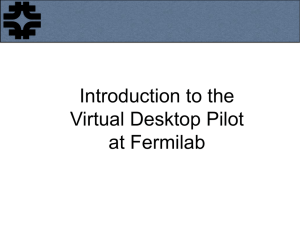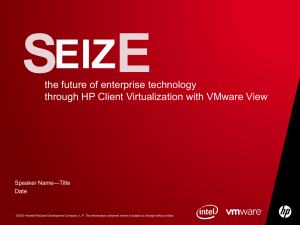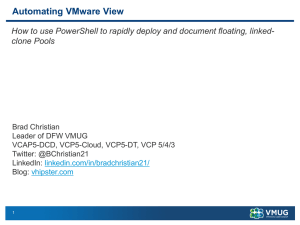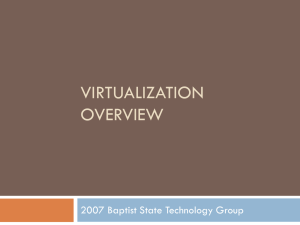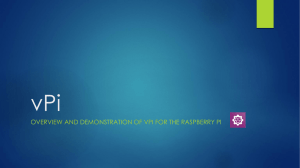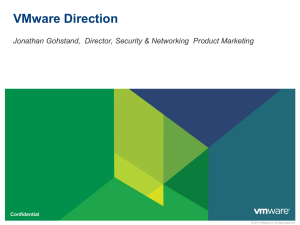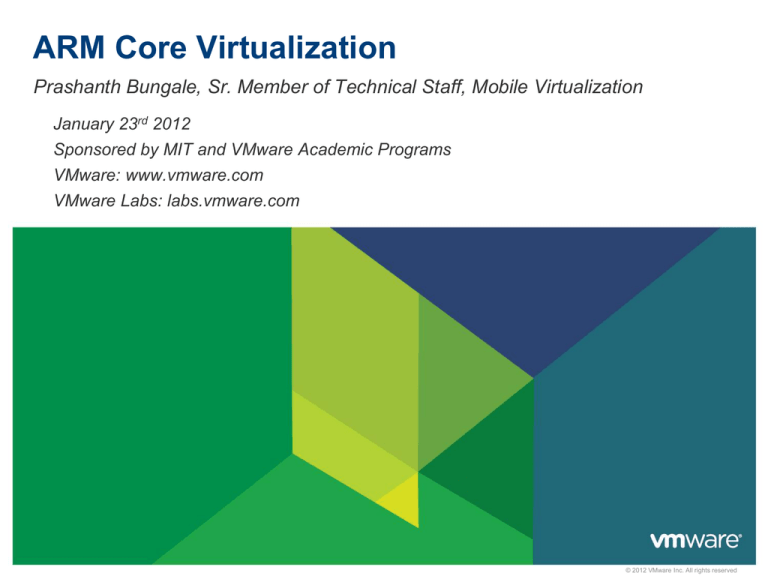
ARM Core Virtualization
Prashanth Bungale, Sr. Member of Technical Staff, Mobile Virtualization
January 23rd 2012
Sponsored by MIT and VMware Academic Programs
VMware: www.vmware.com
VMware Labs: labs.vmware.com
© 2012 VMware Inc. All rights reserved
Agenda
Mobile Virtualization and BYOD Use Case
Overview of ARM CPU State
ARM Instruction Set Virtualization
ARM MMU Virtualization
Comparison of x86 vs. ARM Virtualizability
2
Copyright ® VMware, Inc. All Rights Reserved.
MVP – Manage Corporate Phone on Employee Owned Device
PERSONAL
CORPORATE
♬
One Device – Two Phones
3
Copyright ® VMware, Inc. All Rights Reserved.
Benefits
For enterprises
• Safely support wide diversity of mobile phones accessing corporate assets
• Enforce security and compliance policies
• Reduce device expenses by supporting “bring your own device program”
• Manage Mobile and Desktop from a single interface
• Write corporate applications once and make them portable to multiple
platforms
For employees
• No need to carry two devices anymore
• Have freedom of choice in terms of device they can use for work
4
Copyright ® VMware, Inc. All Rights Reserved.
ARM
5
Predominant architecture in mobile phone world
Over 15 billion chips shipped to date
Over 10 million chips shipped every day
Looking to enter the server/datacenter market in future
5
ARM CPU State
Coprocessor Registers
6
Copyright ® VMware, Inc. All Rights Reserved.
CPSR: Current Program Status Register
N Z C V Q
IT
[1:0]
J
Reserved
GE[3:0]
IT[7:2]
E A
ITSTATE
E ENDIANSTATE
7
F T
Interrupt
Masks
Execution State Registers:
ISETSTATE
I
M[4:0]
Current
Processor Mode
Privileged-only Access Registers
Execution State Registers
Condition Flags
Copyright ® VMware, Inc. All Rights Reserved.
Dealing with Sensitive Instructions
• Interpretation / Full Emulation
• Binary Translation
• Para-Virtualization
• Shallow Para-Virtualization: replace sensitive instructions
• Deep Para-Virtualization: replace sensitive subsystems
• Binary Patching / Pre-Virtualization
• Hardware Assisted Virtualization
8
8
Copyright ® VMware, Inc. All Rights Reserved.
Lightweight Para Virtualization: 1-1 Hypercalls
Replace sensitive instructions with 1-1 Hypercalls
• Use trap instruction to issue hypercall
• Encode hypercall type & original instruction bits in hypercall hint
• Example:
mrs Rd, R <cpsr/spsr>
swi 0x088000
mrs r8, cpsr
Trap and Emulate Semantics
• Upon trapping into the monitor, decode the hypercall type and the original
instruction bits, and emulate instruction semantics
9
Copyright ® VMware, Inc. All Rights Reserved.
MMU Virtualization
Shadow PT
• Intercept guest MMU events of interest
• Data/Prefetch Aborts, TTBR deltas, PT deltas, TLB ops
• Maintain (lazily) VMM-controlled, trusted shadow PT
Para-Virtualized trusted guest PT
• Highly intrusive to guest MMU software
Hardware virtualization support
• Nested / 2-stage Page Tables: VA->PA; PA->MA
10
Copyright ® VMware, Inc. All Rights Reserved.
Privilege Levels & Access Permissions
Guest always executes in machine User mode
• Protect monitor/host from guest
• Avoid virtualization holes
How to protect guest privileged from guest user?
6 distinct guest access permissions
{PNA-UNA, PRW-UNA, PRW-URO, PRW-URW, PRO-UNA, PRO-URO}
Only 3 shadow access permission equivalence classes
{{PNA-UNA, PRW-UNA, PRO-UNA}, {PRW-URO, PRO-URO}, {PRW-URW}}
{{P**-UNA}, {P**-URO}, {P**-URW}}
No injective mapping possible!
11
Copyright ® VMware, Inc. All Rights Reserved.
Dual Shadow Page Tables
Use two shadow page tables for each guest page table
• Privileged/User shadow PTs
• Switch on privilege mode switches
12
Guest AP
Priv. Shadow AP
User Shadow AP
PNA-UNA
P**-UNA
P**-UNA
PRW-UNA
P**-URW
P**-UNA
PRW-URO
P**-URW
P**-URO
PRW-URW
P**-URW
P**-URW
PRO-UNA
P**-URO
P**-UNA
PRO-URO
P**-URO
P**-URO
Copyright ® VMware, Inc. All Rights Reserved.
{User, Priv} Shadows
Shadow User page table
Guest page table
Shadow Priv. page table
13
Copyright ® VMware, Inc. All Rights Reserved.
Comparison of ARM vs. x86 Virtualizability
Sensitive Instructions
Type of Sensitive
Instructions
Violating
Goldberg’s
Requirement #
X86 [3]
ARM
Sensitive Register
Access
3B
SGDT, SIDT, SLDT,
SMSW, PUSHF/POPF
-
Protection System
References
3C
LAR, LSL, VERR, VERW,
PUSH/POP, CALL, JMP,
INT n, RET, STR, MOVE
LDM/STM (user regs),
LDRT/STRT (“As User”)
Both
3B & 3C
-
MRS, MSR, CPS, SRS,
RFE, DPSPC,
LDM (exc. return)
[3] John Scott Robin and Cynthia Irvine, Analysis of the Intel Pentium’s Ability to Support a
Secure Virtual Machine Monitor, USENIX Security Symposium, 2000.
14
Copyright ® VMware, Inc. All Rights Reserved.
Comparison of ARM vs. x86 Virtualizability
Ring compression – protection mechanisms
• x86: Segmentation + Paging
• ARM: Paging (+ domains?)
Instruction execution vs. Data Read/Write protection
• x86: CS for instruction fetch vs. DS/other for data access
• ARM: No explicit distinction b/w execute and read protection
Cache architecture
• x86: Largely transparent; PIPT across all versions
• ARM: Exposes a lot of the cache architecture; VIVT/VIPT/PIPT
15
Copyright ® VMware, Inc. All Rights Reserved.
Comparison of ARM vs. x86 Virtualizability
Instruction size
• x86: Variable
• ARM: Fixed -> enables in-place patching mechanisms
I/O
• x86: I/O instructions + memory-mapped I/O
• ARM: Only memory-mapped I/O
16
Copyright ® VMware, Inc. All Rights Reserved.
Thank You!
17
Copyright ® VMware, Inc. All Rights Reserved.
Next in IAP VMware Mobile Virtualization series…
Mobile I/O virtualization
• Mobile VMs interact with virtual I/O devices
• E.g. touchscreen, display, storage, GPS, Bluetooth, WiFi, GSM, GPU,
cameras, accelerometers, audio, keyboard, etc.
• Explore I/O virtualization techniques with a mobile focus
Application-level virtualization
• Deprivileged hypervisor design and implementation
• Distribute a hypervisor via a mobile app store
Programming exercise
• Based on today’s talk and the concepts from application-level virt.
• Complete the exercise, enter a draw for exciting prize (iPad!)
18

